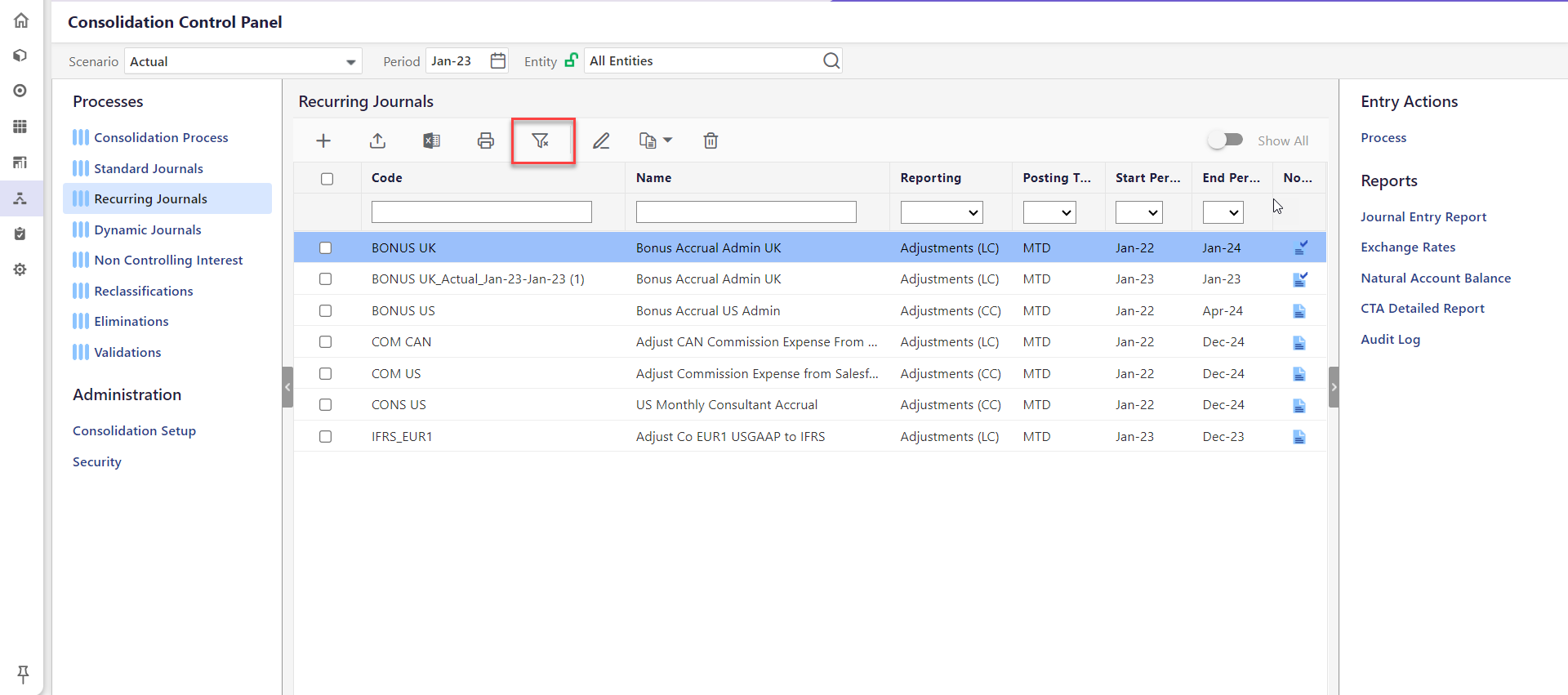- 7 Minutes to read
- Print
- DarkLight
- PDF
Using Recurring Journals
- 7 Minutes to read
- Print
- DarkLight
- PDF
Recurring Journal Entries are entries that do not change across time. These entries are regular journal entries with automatic creation over the selected period. For example, depreciation expense of a trucking organization that depreciates the value of their trucks every period by 10 percent. The organization can create a recurring journal entry to debit the Depreciation Expense account and credit the Accumulated Depreciation account. Using the Recurring Journal, you can automate creation of entries and consistently apply them for each period within the consolidation process. This reduces manual intervention, eliminates chances of manual error, and brings efficiency..gif)
Below are the functionalities available for recurring journals.
How to Add a Recurring Journal?
Create Recurring Journals to repeat the same entry every accounting period. For example, if a user has an annual expense (such as rent), the expense can be accrued in twelve equal payments every month with a Recurring Journal entry. The user can accrue rent for the current period, which will be paid in the following period.
Rent Expense: $100,000
Rent Payable: $100,000
In this case, a debit and credit to the appropriate segment intersections will be created every month. Another example is a trucking organization that depreciates the value of their trucks every period by 10 percent. Or, accruals for utilities, telephone, property taxes, interest, or commissions.
Perform the below steps to add a recurring journal:
Navigate to Consolidation to open the Consolidation Control Panel.
Select Scenario, Period, Entity.
Click the Recurring Journals Process.
In the center pane, click Add to launch the Add Journal page.

Enter a Code and Name of choice.

Select the Period for the journal entry.
Select Posting Type. By default, for the Posting Type, YTD (year to date) is displayed.
Note:
MTD evaluates entries based on the month’s activity whereas YTD evaluates the entries based on the cumulative balance for the line items.
Select a common currency or local currency for reporting purposes (Adjustments CC or Adjustments LC).
Note:
A local currency is often used by a company's subsidiaries and then converted to a common currency for consolidated reporting purposes.
Click Add Row to add a line item.

Note:
Segment columns displayed are based on application configuration and user security. The Total field displays the Total Debit/Total Credit amount for the entire column as well as the running variance column. Validations exist to ensure that the entry is balanced before saving.
Select the relevant dimension values for the recurring journal entry.
To move several rows of journals, drag and drop each row to the correct place on the grid.
Click the Duplicate Row icon to duplicate a current line, including; the description, segment selections, and debit/credit values. When a line is duplicated the new line is placed, in edit mode, directly below the line selected for duplication.
Copy and paste line items from an Excel spreadsheet into the journal entry grid. Copy/paste all values including; description, segments, and debit/credit. Use shortcut keys (Ctrl+C, Ctrl+V).
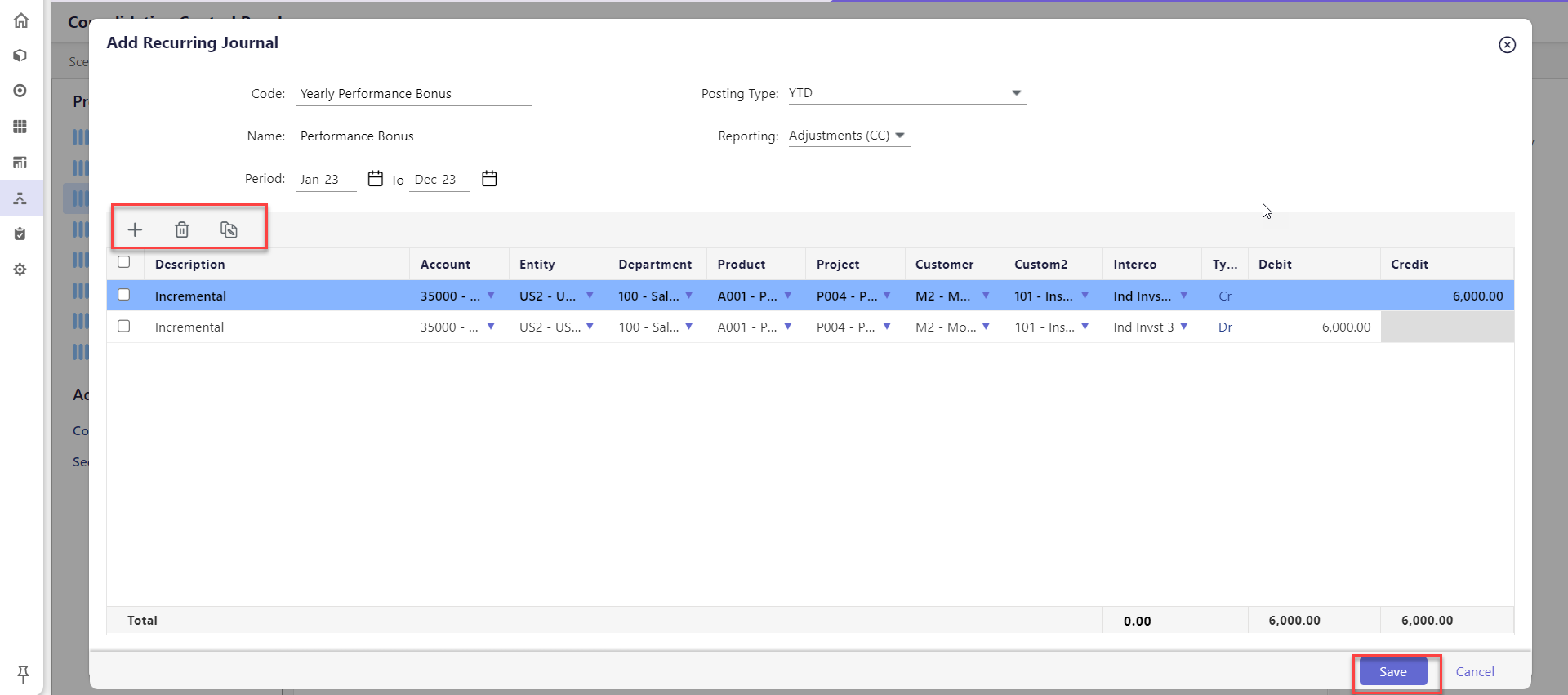
Note:
Use the auto-complete feature to select segment members quickly. Start typing a code if known, and the list of available members will be automatically filtered based on the letter or number entered.
Click Save.
How to Upload a Recurring Journal?
Upload Recurring Journals in xlsx format directly to the Consolidation module. Use the sample template (that can be downloaded) for ease of use when performing the upload.
Note:
The user must download and use the sample templates as they are journal-specific. For example, the user can’t use the Standard Journal template to upload Dynamic Journals.
Perform the below steps to upload recurring journals:
Navigate to Consolidation to open the Consolidation Control Panel
Select Scenario, Period, Entity.
Click the Recurring Journals process.
If no Recurring Journals were created or uploaded then this pane will be blank. The user can opt to upload or enter journals or do a medley of both. Click the Recurring Journals Upload icon shown below.
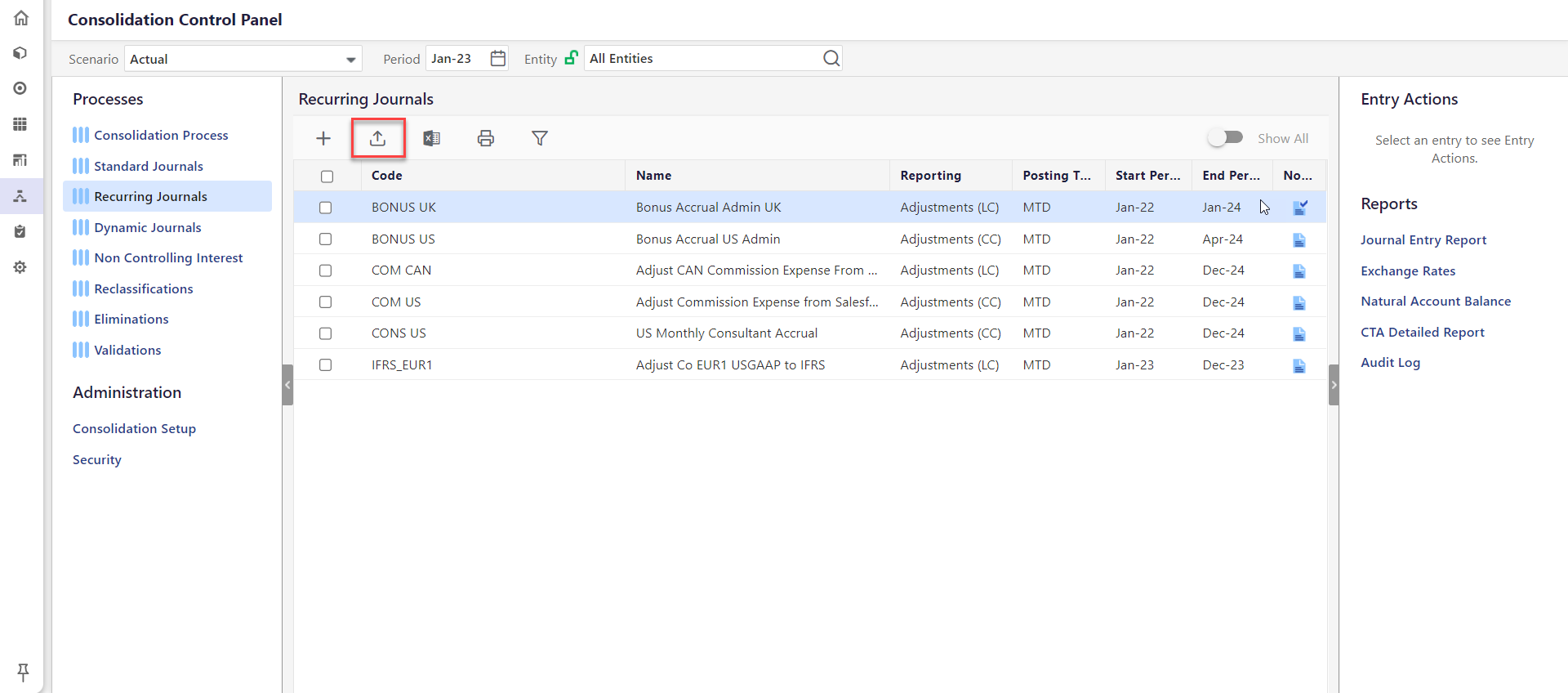
The Recurring Journals Upload dialog appears. It is best practice to use the sample Excel template, as it demonstrates exactly how journal data needs to be organized for successful loading. Click Download sample Excel template.
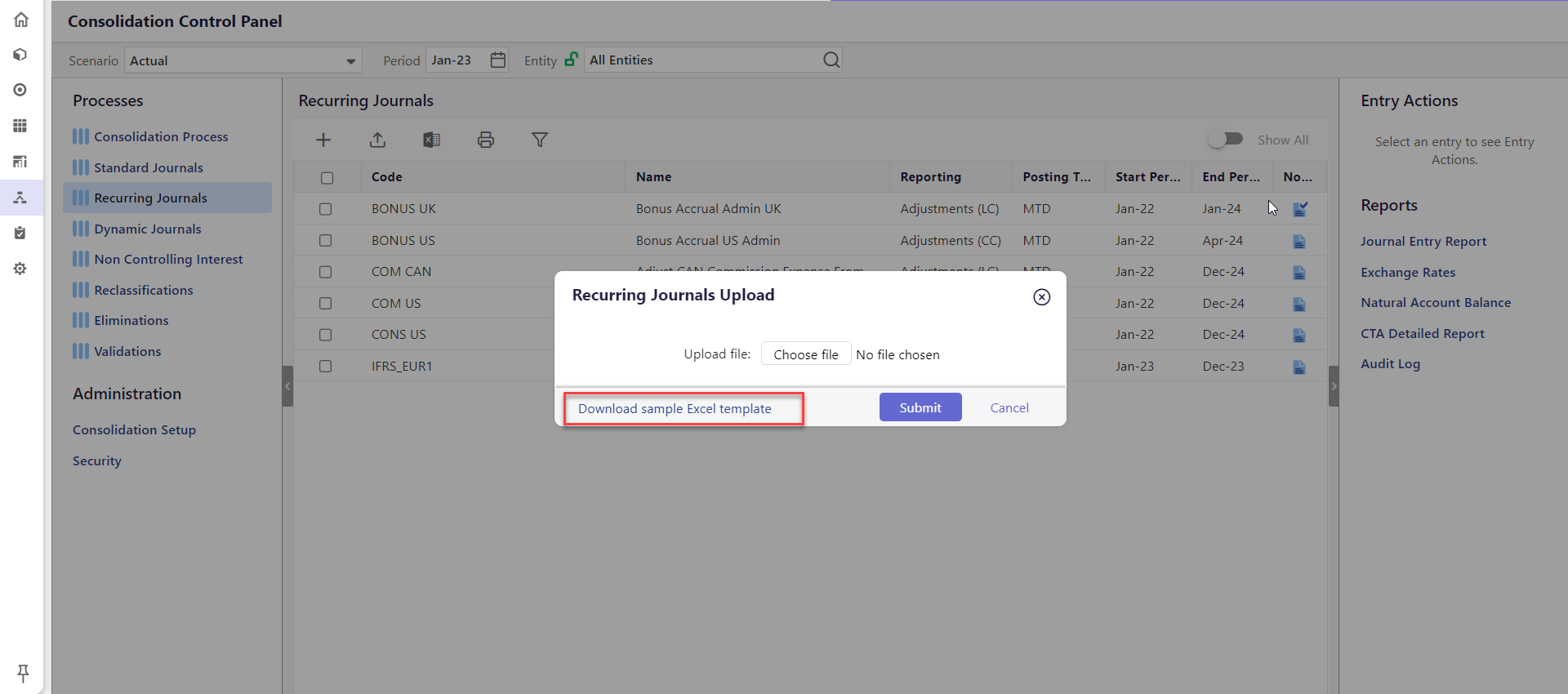
The template is downloaded on your local system. Open the template.
The template displays and indicates the required fields. It also provides information to ensure the correct data is entered where needed.
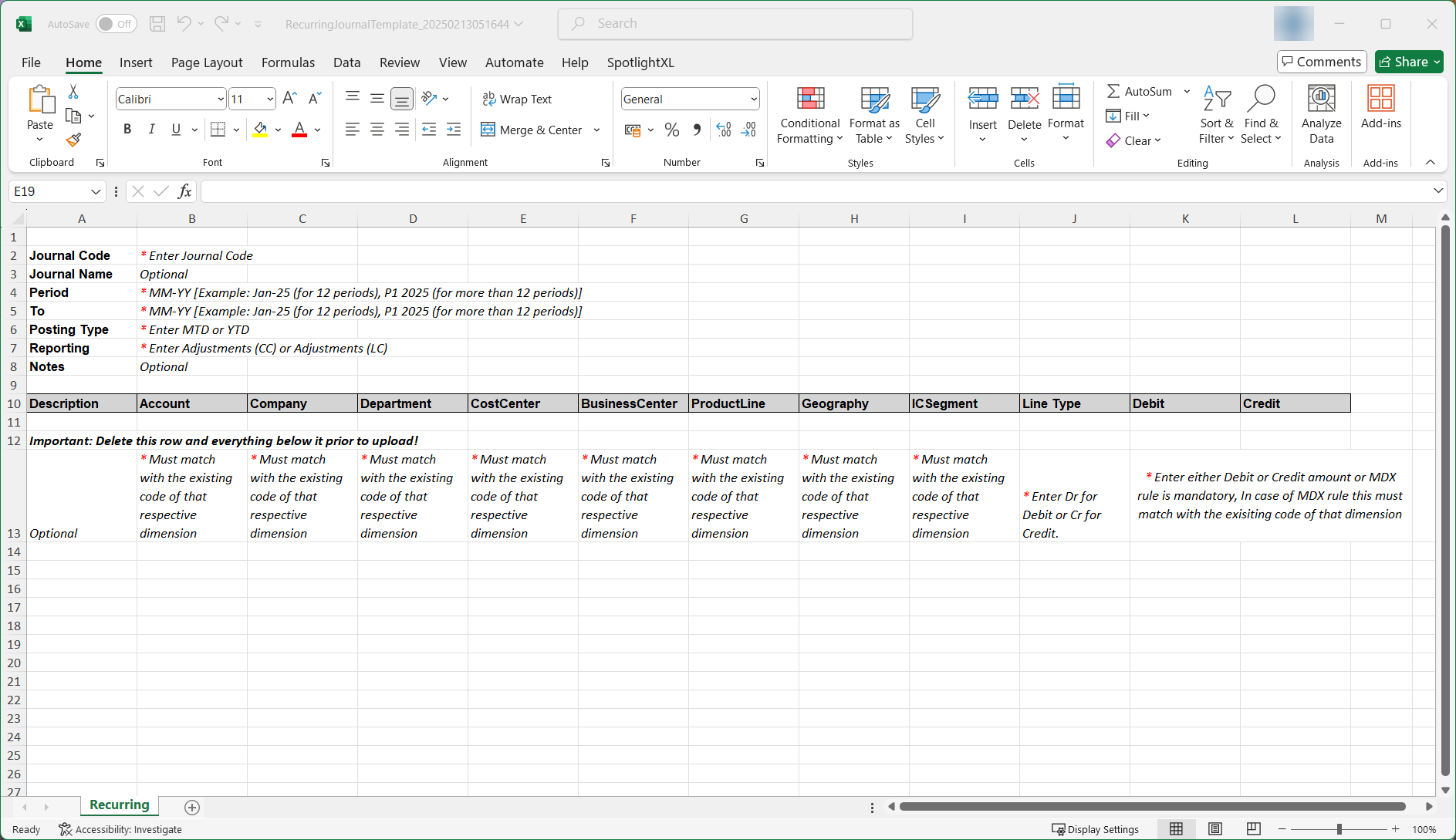
Enter a Journal Code, the period for loading the journals, and the posting type.
Enter Adjustments (CC) or Adjustments (LC) for reporting and enter notes as needed.
Now, the journal data is ready for copy and paste into the spreadsheet. Before copying and pasting data to the Excel file, ensure to delete all the tips.
Save the xlsx file to the computer.
Back in the Consolidation Control Panel, click Choose File.

Select the file saved to the computer and click Submit. Once processing is complete, the uploaded Recurring Journal will appear in the center pane.
If the file fails to upload, download the failed file to view the cause(s) of the failure, fix the file, and upload again.
How to Edit a Recurring Journal?
Perform the below steps to edit a recurring journal:
Navigate to Consolidation to open the Consolidation Control Panel.
Select Scenario, Period, Entity.
Click Recurring Journals under Processes.
Select the checkbox beside the journal to enable the Edit option.

Click Edit. The Edit Recurring Journal dialog appears.
Edit as needed.
Note:
The user can also use Add Row, Delete Row, and Duplicate Row to add a new entry, delete an entry, or copy an existing entry.

Click Save to save the changes and to exit the Edit Recurring Journal dialog.
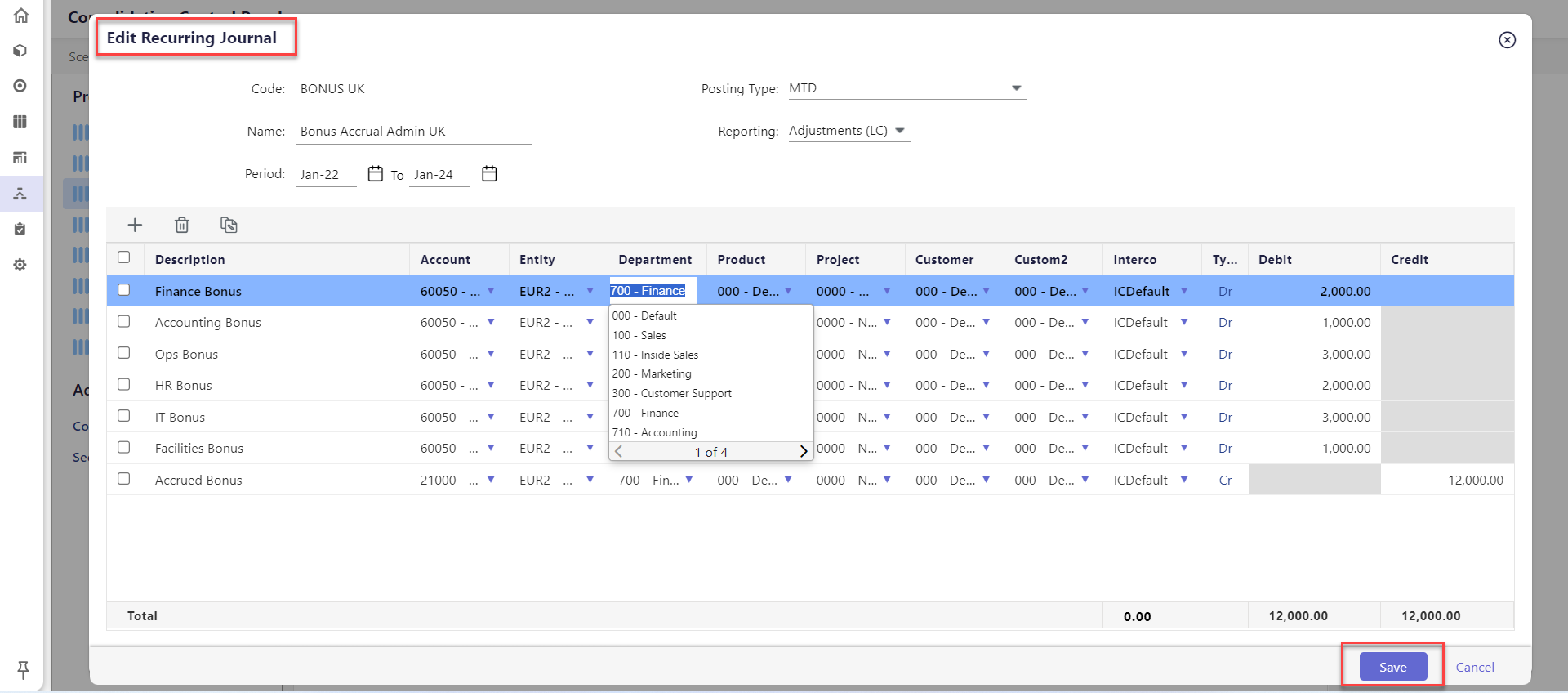
How to Copy a Recurring Journal?
Perform the below steps to copy a recurring journal:
Navigate to Consolidation to open the Consolidation Control Panel
Select Scenario, Period, and Entity.
Under Processes, click Recurring Journals.
Select the desired Recurring Journal and click Copy.
.png)
Select Single Copy. The Copy Recurring Journal dialog appears.
Note:
The user can also copy recurring journals from one scenario to another using the Copy Multiple option. Perform the below steps to do so:
Select Copy Multiple. The Copy page appears.
Enter a Code and Name and select period dates.
Select the Target Scenario.

Complete all selections based on the process being copied.
Select the Email notification checkbox to receive an email notification when the process is completed.
Click OK.
If the user selects multiple entries to copy, the Copy Single option will not be available.
Complete all the fields. Changes can also be made to the existing Posting Type, Reporting, and Period here.
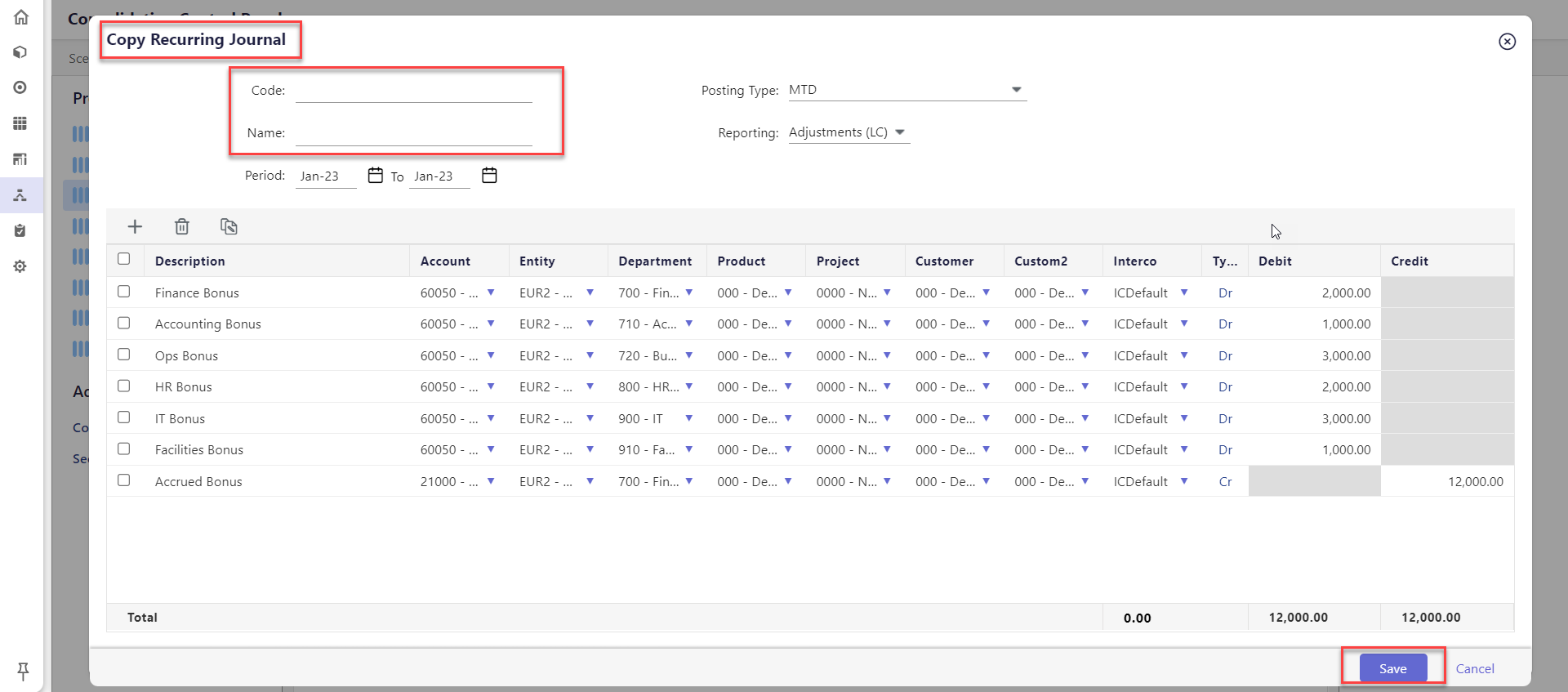
Click Save.
Note:
It is a best practice to limit the number of copied journals and journal lines to a combined total of 30,000 (journals + lines). For example, 1000 journals with no more than 30 lines. Or, 60 journals; each of which has no more than 500 lines.
How to Delete a Recurring Journal?
Perform the below steps to delete a recurring journal:
Navigate to Consolidation to open the Consolidation Control Panel.
Select Scenario, Period, and Entity.
Click Recurring Journals under Processes. The Recurring Journals grid appears.
Select the Recurring Journal to enable the Delete option.
Click Delete.
.png)
In the confirmation dialog that appears, click OK. The Recurring Journal(s) will be deleted.
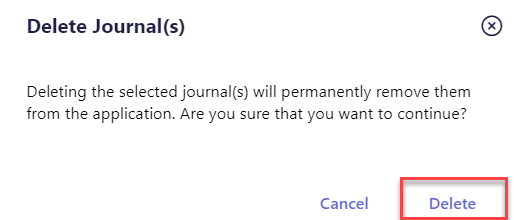
All journals can be deleted together. In the image below, 7 Recurring journals are selected and available for deletion.
Processing a Recurring Journal Entry
You can process a Recurring Journal when all the entries in the journal are accurate and ready to be posted frequently for specific periods. Furthermore, you can process one or more Recurring Journals at a time. Once a Recurring Journal is posted, it converts into a Standard Journal entry and becomes available in the Standard Journal tab. Additionally, you can post a Recurring Journal with create, overwrite, or post Standard Journal actions based on your requirements.
Let’s understand this with an example:
In the Recurring Journal tab, select the Bonus UK journal. Click on the process action, the Process Recurring Journals dialog box pops up..png)
This journal can be processed for multiple periods, for example, Jan-23 to March-23. Along with multiple period processing, it is possible to select the Create Standard Journals, Overwrite Standard Journals, and Post Standard Journals processing options, or select all.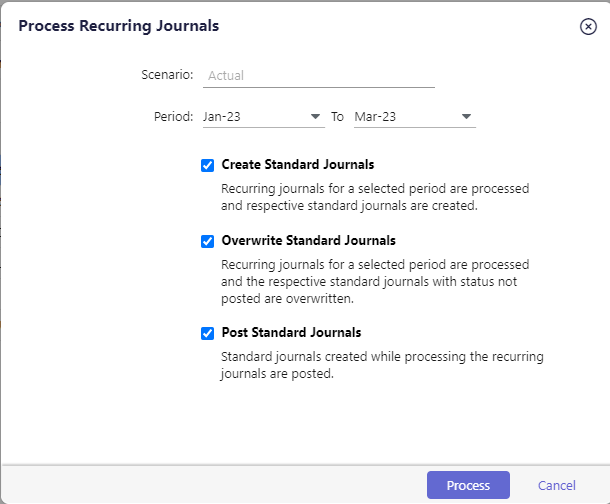
This process will create relevant standard journals, post those standard journals, and overwrite the standard journals in case they have already been processed but not posted.
How to Process a Recurring Journal?
Perform the below steps to process recurring journals:
Navigate to Consolidation to open the Consolidation Control Panel.
Select Scenario, Period, and Entity.
Click Recurring Journals under Processes. The Recurring Journals grid appears.
Select one or all Recurring Journals and click Process.
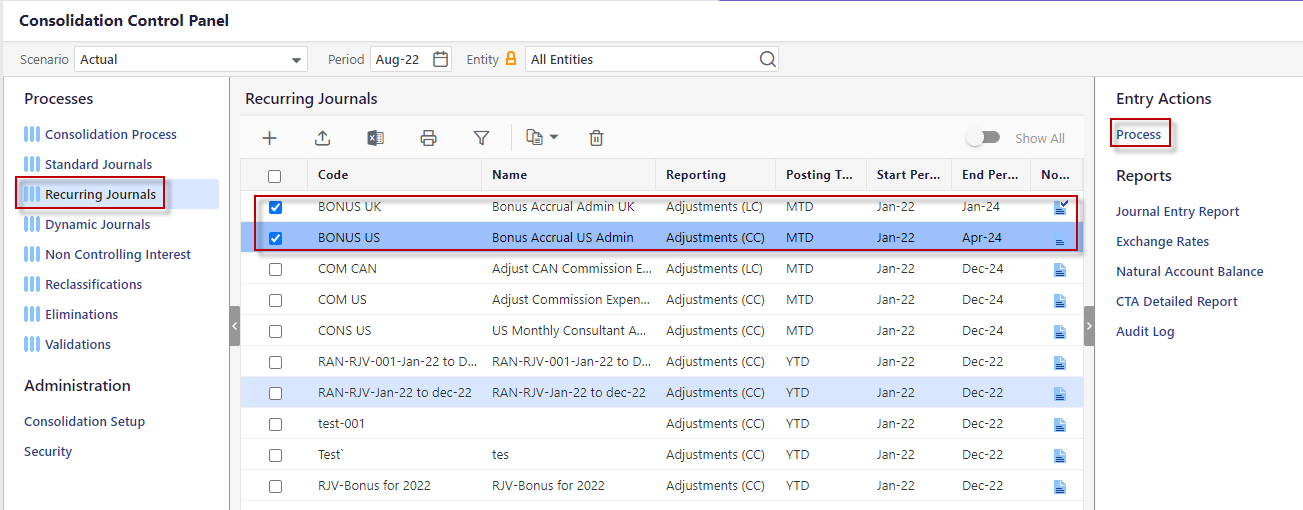
Or

In the Process Recurring Journals dialog box, select From and To period.
Select either one or a combination of these processing options:
Create Standard Journals: This option processes recurring journals for a selected period and creates respective Standard Journals.
Overwrite Standard Journals: This option processes recurring journals for a selected period and overwrites the standard journals with status not posted.
Post Standard Journals: This option posts the standard journals created while processing the recurring journals.
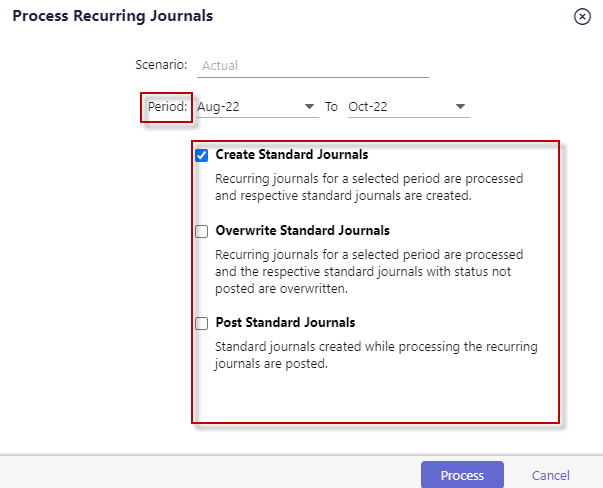
Or
Click Process.
The Automated Data Collection (ADC) task is triggered and the user will receive a notification once the processing is complete.
In the Standard Journals screen, standard journals created and posted for the respective period can be seen.
Note:
Only users having full access to Standard Journals can select the Post Standard Journals processing option.
Export as Excel
Perform the below steps to export the details of recurring journals:
Navigate to Consolidation to open the Consolidation Control Panel.
Select Scenario, Period, and Entity.
Click Recurring Journals under Processes. The Recurring Journals grid appears.
Click Export as Excel to download the recurring journal Excel report.
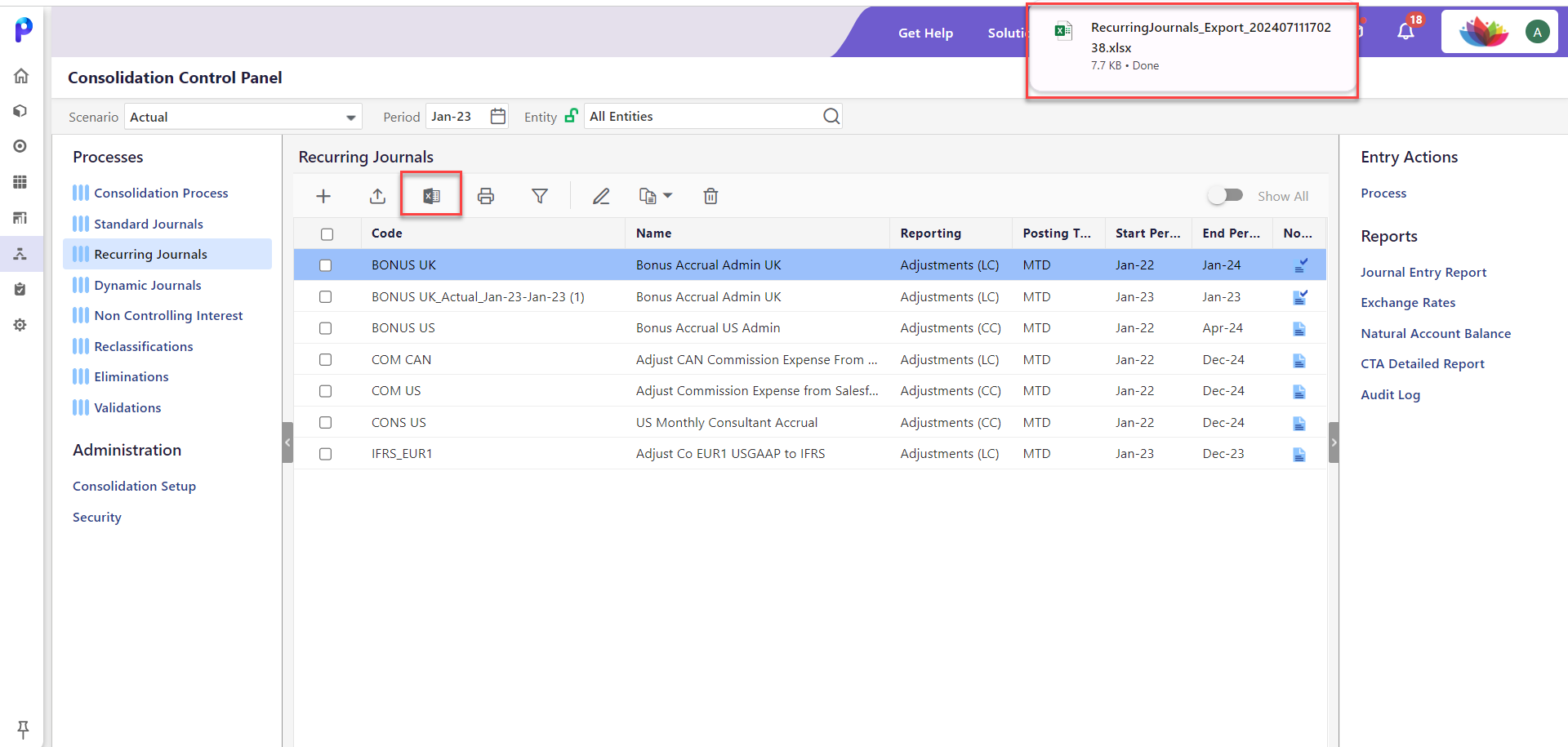
Print
Perform the below steps to print the details of recurring journals:
Navigate to Consolidation to open the Consolidation Control Panel.
Select Scenario, Period, and Entity.
Click Recurring Journals under Processes. The Recurring Journals grid appears.
Click Print to print out the recurring journals list.
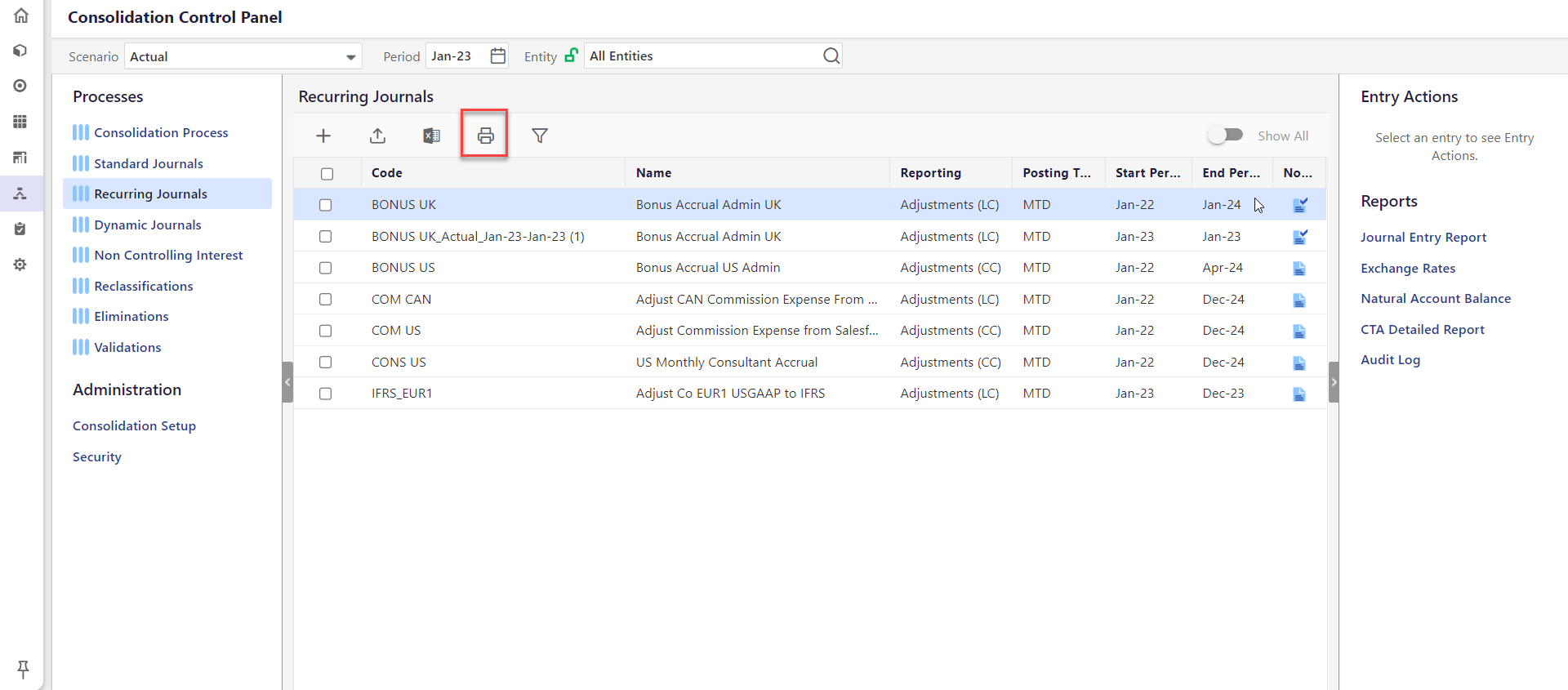
Apply Filter
Perform the below steps to apply/clear the filter:
Navigate to Consolidation to open the Consolidation Control Panel.
Select Scenario, Period, and Entity.
Click Recurring Journals under Processes. The Recurring Journals grid appears.
Click Apply Filter to filter out journals based on Code, Name, Reporting, Posting Type, and Period.
